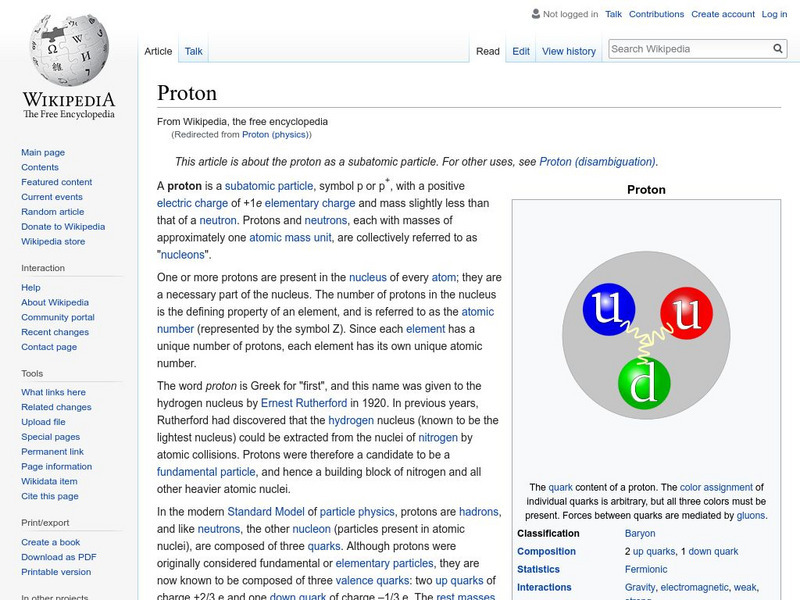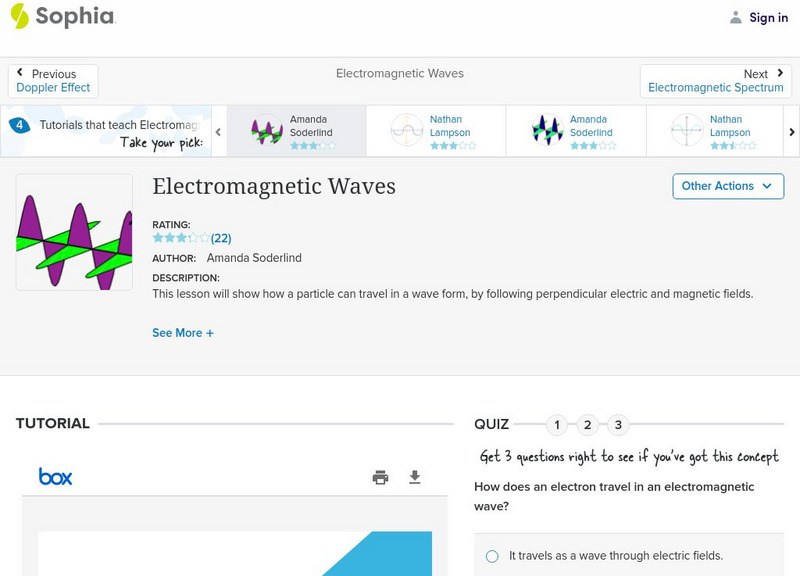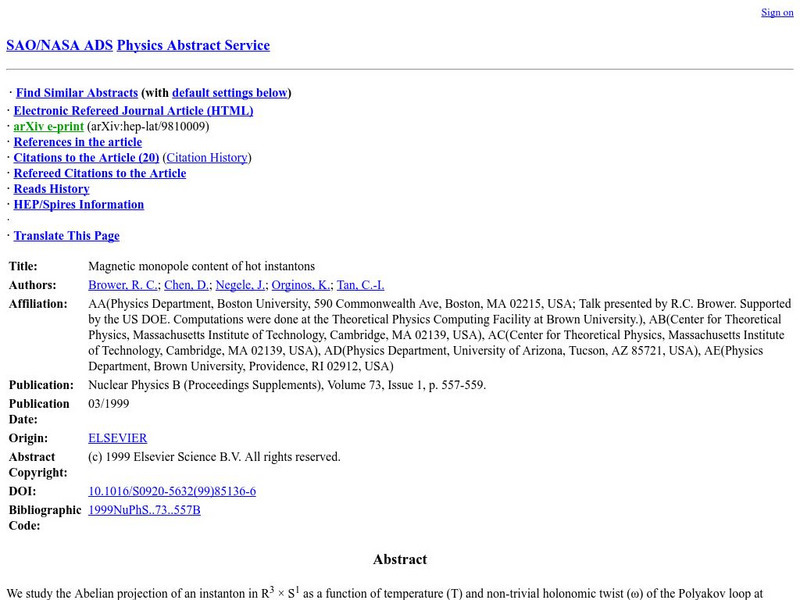Khan Academy
Khan Academy: Genesis Effect
Using the interactive tool, see what kind of looks you can achieve with this Genesis effect inspired simulator.
Symmetry Magazine
Symmetry Magazine: Explain It in 60 Seconds: X Ray Lasers
X-ray lasers are produced by electron beams and are extremely intense,. They have important applications in particle physics. "Explain It In 60 Seconds" is an article series that aims to summarize in a few paragraphs the meaning of...
Khan Academy
Khan Academy: Photoelectric Effect
Explaining the experiments on the photoelectric effect. How these experiments led to the idea of light behaving as a particle of energy called a photon.
TED Talks
Ted: Ted Ed: Group Theory 101: How to Play a Rubik's Cube Like a Piano
Mathematics explains the workings of the universe, from particle physics to engineering and economics. Math is even closely related to music, and their common ground has something to do with a Rubik's Cube puzzle. Michael Staff explains...
Symmetry Magazine
Symmetry Magazine: Explain It in 60 Seconds: Superconductors
Superconductors are materials that offer no resistance to electricity passing through them. They have many applications in science, such as in the Large Hadron Collider. "Explain It In 60 Seconds" is an article series that aims to...
Symmetry Magazine
Symmetry Magazine: Explain It in 60 Seconds: A Theory
The definition of a theory as it applied to science is explained in this brief article. "Explain It In 60 Seconds" is an article series that aims to summarize in a few paragraphs the meaning of different concepts in particle physics.
Ducksters
Ducksters: Physics for Kids: Light
Kids learn about the science of light. Energy made of waves and particles called photons traveling at the top speed in the universe. What is refraction? The difference between transparent, translucent, and opaque.
National High Magnetic Field Laboratory
Magnet Academy: Enrico Fermi
Enrico Fermi was a titan of twentieth-century physics. He outlined the statistical laws that govern the behavior of particles that abide by the Pauli exclusion principle and developed a theoretical model of the atom in his mid-twenties....
Famous Scientists
Famous Scientists: Walther Wilhelm Georg Bothe
Find out about a German nuclear physicist, who won the Nobel Prize in Physics in 1954 for his work in study of nuclear reactions, the Compton effect, cosmic rays, and the wave-particle duality of radiation.
Wikimedia
Wikipedia: The Black Hole
This site examines the black hole as an object in astrophysics. Delve into this comprehensive resource that covers this concept from its history, to qualitative physics, the reality of black holes, mathematical physics and more.
National High Magnetic Field Laboratory
Magnet Academy: Timeline of Electricity and Magnetism: 1960 1979
Computers evolve into PCs, researchers discover one new subatomic particle after another and the space age gives our psyches and science a new context.
National High Magnetic Field Laboratory
Magnet Academy: Timeline of Electricity and Magnetism: 1910 1929
Scientists' understanding of the structure of the atom and of its component particles grows, the phone and radio become common, and the modern television is born.
Wikimedia
Wikipedia: Proton
Wikipedia offers information on the proton, a subatomic particle with a positive electric charge. Many hyperlinked terms.
Soylent Communications
Notable Names Database: Ernest Lawrence
This brief biography discusses the innovative work of physicist Ernest Lawrence, inventor of a magnetic resonance particle accelerator.
Sophia Learning
Sophia: Electromagnetic Waves: Lesson 1
This lesson will show how a particle can travel in a wave form, by following perpendicular electric and magnetic fields. It is 1 of 4 in the series titled "Electromagnetic Waves."
National High Magnetic Field Laboratory
Magnet Academy: Felix Bloch (1905 1983)
Physicist Felix Bloch developed a non-destructive technique for precisely observing and measuring the magnetic properties of nuclear particles. He called his technique "nuclear induction," but nuclear magnetic resonance (NMR) soon became...
National High Magnetic Field Laboratory
Magnet Academy: Timeline of Electricity and Magnetism: 1900 1909
Albert Einstein publishes his special theory of relativity and his theory on the quantum nature of light, which he identified as both a particle and a wave. With ever new appliances, electricity begins to transform everyday life.
MadSci Network
Msn: What Regulates the Speed of Hydrogen Fusion?
From the Mad Scientist Network web site. Using a question and answer format, this page describes the various types of fusion processes and the physical requirements needed for their initiation and sustenance. Factors affecting the rates...
National High Magnetic Field Laboratory
Magnet Academy: Julian Schwinger
Theoretical physicist Julian Schwinger used the mathematical process of renormalization to rid the quantum field theory developed by Paul Dirac of serious incongruities with experimental observations that had nearly prompted the...
National High Magnetic Field Laboratory
Magnet Academy: Joseph John Thomson
Joseph John Thomson, better known as J. J. Thomson, was a British physicist who first theorized and offered experimental evidence that the atom was a divisible entity rather than the basic unit of matter, as was widely believed at the...
TED Talks
Ted: Ted Ed: Brian Greene on String Theory
Physicist Brian Greene explains superstring theory, the idea that minscule strands of energy vibrating in eleven dimensions create every particle and force in the universe. [19:11]
Other
National Academy of Sciences: Biography of Rodney Cool [Pdf]
Rodney Lee Cool spent much of life's work on hyperons. This is the classic biography of a real-life scientist, a particle physicist. It's touching and enlightening, complete and full of science and significance. Requires Adobe Reader. [PDF]
Read Works
Read Works: Nasa Stardust Review
[Free Registration/Login Required] An informational text about NASA's probe, Stardust, which recently completed a seven-year journey to explore space and collect particles. A question sheet is available to help students build skills in...
Harvard University
Boston University: Magnetic Monopoles
Informative, nontechnical questions are provided as well as answers regarding magnetic monopoles. This is a very useful site for getting an introduction to the search for these theoretical particles.



















